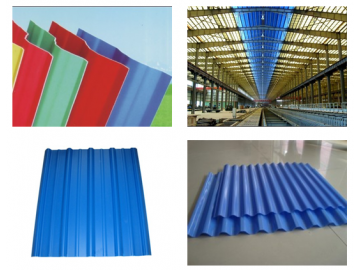FRP daylighting tiles are widely used in China due to their advantages such as corrosion resistance, aging resistance, impact resistance, high light transmittance, aesthetic molding, low cost, energy-saving and environmentally friendly properties, excellent aging and corrosion resistance, good light transmission, flame retardancy, long-lasting performance, and rich colors.
FRP daylighting tiles are composed of high-performance surface film, reinforced polyester, and fiberglass. The surface film plays a crucial role in providing excellent UV resistance and static electricity resistance. UV resistance is essential to protect the polyester of the FRP daylighting panels from yellowing and aging, which would cause a premature loss of light transmittance. Static electricity resistance ensures that dust on the surface is easily washed away by rain or blown away by wind, maintaining a clean and aesthetically pleasing surface.
Installation and Usage
1. Before fixing the daylighting tiles, pre-drilled holes are required. The hole diameter must be greater than 50% of the diameter of the fixing screws to avoid internal stress cracking due to thermal expansion and contraction.
2. The daylighting tiles are fixed using aluminum profile fasteners. The corrugated daylighting tiles are connected and fixed using daylighting tile brackets and self-tapping screws, followed by sealing with adhesive. The position of the daylighting tiles is generally set at the mid-span.
3. When overlapping the daylighting tiles with steel sheets in the longitudinal direction, there must be a minimum overlap of 200mm, and two waterproof strips should be applied.
4. When connecting the daylighting tiles with self-tapping screws, a cover plate is required. The sunlight panels have significant thermal deformation and are prone to being cut by self-tapping screws, so larger holes should be made where the self-tapping screws are applied. Consideration should be given to the thermal expansion of the daylighting panels during installation.
5. When fixing the daylighting tiles, high-quality water dam washers must be used between the screws and the daylighting panels to ensure waterproofing and dustproofing. After inserting the water dam washers into the screws, use a power drill to lock them into the purlins, thus completing the fixing of the daylighting panels.
6. Daylighting tiles do not require overlapping if they are within 12m. If they exceed 12m, overlapping is required, with an overlap length of 200 - 400mm. Apply two coats of sealant at the overlapping areas. For horizontal overlaps, edge trimming is not necessary, while for longitudinal overlaps with color-coated steel sheets, it depends on the panel type. Generally, for ordinary embossed steel sheets, no edge trimming is considered; they are directly fixed with self-tapping screws and sealed with adhesive. Edge trimming is required for interlocking panels.
7. During construction, it is strictly forbidden to step directly on the peaks of the waves to avoid cracking the daylighting panels. A non-slip thick wooden board measuring 1200mm x 300mm (length x width) must be placed on the transverse position of the daylighting panels, and the work of drilling guide holes and fixing screws should be carried out while standing on it.
Application Range
Used for industrial factory roof and wall lighting, agricultural vegetable greenhouses for insulation and lighting, public sports venue roofing, and special requirements for buildings such as flame retardancy, corrosion resistance, and thermal insulation. Additionally, they are applied in warehouses, greenhouses, train stations, docks, airports, commercial buildings, steel structures, and many other daylighting fields.













